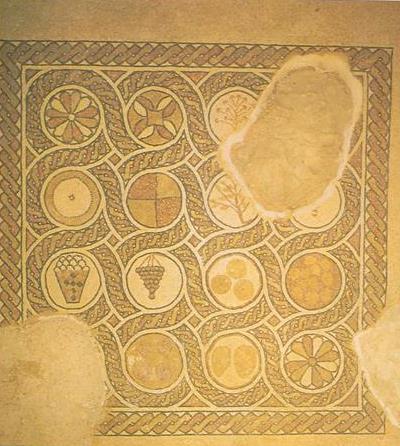Byzantine Chapel at Masada
This is Yigael Yadin’s description of the discovery of the mosaic floor in the Byzantine chapel of Masada.
To the south of the residential building stands a well-preserved structure which was always the first and most conspicuous ruin to catch the eye of visitors who had been attracted to the Masada summit over the last hundred years. Because of its plan it was easy to identify, and it had in fact long been identified by scholars as a Christian chapel of the Byzantine period, consisting mainly of a long hall and an apse at its eastern end. Its walls are preserved to a considerable height and are covered with plaster bearing such original decoration as pottery shreds and small stones set in geometric patterns and floral designs.
We decided to make an excavation here, too, particularly because of the description by one of the first scholars to visit this site, the well-known de Saulcy, of his finds in this building. De Saulcy, in his Memoirs, writes that he saw, scattered about the main hall, portions of mosaic flooring; and he innocently adds that with the help of baksheesh which he gave to his Bedouin helpers, he succeeded in clearing parts of the floor. To his deep regret, however, he found that most of it was destroyed, and he was able to take away as a memento only a few pieces, and these he entrusted to the Louvre. When we came to clear this main hall, we found that there was almost no sign either of floor or portions thereof, the result, no doubt, of the not inconsiderable baksheesh which de Saulcy had thought fit to hand to his Bedouin companions. Only in the western corner were there a few fragments of colored mosaic with a geometric design.
We had little hope of finding anything of significance, but since we had started we thought it as well to continue, and we therefore extended our dig to the chambers adjoining the main hall. Running off the north-west corner of the hall was a long room, which apparently served as the living quarters for the church beadles, where we found cupboards and washing vessels. But the principal reward for our intensive work on this site was found in a small chamber off the northern side of the hall. The pile of debris here was very high indeed, and this had apparently discouraged de Saulcy from digging. When we got down to the northern edge of the floor in this room, we glimpsed part of a mosaic which looked as if it might be complete. Unfortunately, the small stones making up the mosaic were not of good quality, and they almost disintegrated at the touch of a hand. Great patience and skill were necessary if the whole floor was to be uncovered without damage. Happily, one of the English volunteers was an expert who had specialized in dealing with mosaics and she, together with a few other volunteers, spent many days uncovering this mosaic. It was painstaking – and back-breaking – work, bending over the floor and carefully and gently brushing off the earth and dust from every stone. Each day they would manage to uncover another few square inches.
mosaic were not of good quality, and they almost disintegrated at the touch of a hand. Great patience and skill were necessary if the whole floor was to be uncovered without damage. Happily, one of the English volunteers was an expert who had specialized in dealing with mosaics and she, together with a few other volunteers, spent many days uncovering this mosaic. It was painstaking – and back-breaking – work, bending over the floor and carefully and gently brushing off the earth and dust from every stone. Each day they would manage to uncover another few square inches.
The picture on page 114 taken with a wide-angled lens shows the whole of the eastern part of the room, with its walls and windows, as it looked during excavation. When the work of clearance was completed, what lay revealed was a complete Byzantine mosaic floor, one of the most beautiful of those known of this period. Its design is a series of round medallions, in each of which are representations of fruit and plants, such as pomegranates, figs, oranges and grapes. From the style of this mosaic we are able to date the building of the chapel and ascribe it to the 5th century.
Another interesting find was what seems to have been a workshop for the manufacture of stones for mosaics. It contained a quantity of long thin stones, the raw material, no doubt, from which the small mosaic ingredients were cut. A detailed examination of the mosaic floor of the chapel showed that this workshop also belongs to the Byzantine period.
As a result of our excavation, we now know that the Byzantine settlement consisted only of a small group of monks who lived on Masada, just as monks established themselves in other places in the Judean wilderness in the 5th century and later, seeking remote retreats far from the city, but preferably those which had buildings which they could use. The monks on Masada dwelt in small cells scattered over the summit. Some also lived in the caves, as is suggested by the crosses we found painted on the walls. It is assumed that they were forced to leave this location with the Persian or Moslem conquest of the country at the beginning of the 7th century. Since then Masada has remained unoccupied.
Yigael Yadin. Masada. Random House Press, New York, 1966. p. 111-115.
See also-




